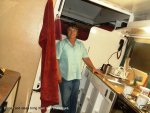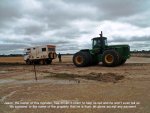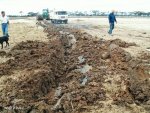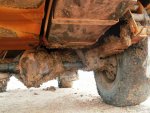It was kind of him to try to retrieve us. And his road grader was eventually recovered, but not until several weeks later--deep into summer.
------
Day One
It's a snowy, wet May on California's Modoc Plateau. It's remote, it's decades ago, I'm a budding 23-year-old field ecologist.
The country is gritty and lovely. It's capped with basalt and clay, juniper and Jeffrey pine. Swales and wetlands pock the woodlands, and cold willowy creeks fill rocky recesses.
And it's been wet--soaking wet, and cold--for weeks. Snow storms. Then rain. Then slush. Every rivulet runs water. Each hoof print is two tiny pools.
We're collecting data, and there's more country to measure than time. Our too-many plots are best accessed by a Toyota truck, well-drained cinder roads, and dicey networks of two-track reaching past that.
Up to this point, we've fared well navigating the waterlogged terrain with equal measures of caution and luck.
The two-tracks, as they weave through duffy stands of jeffrey pine, are generally safe, but the meadows between those stands can be treacherous mud.
My procedure, exercised religiously, is to walk tracks crossing meadows before driving them. And it's worked, yielding successful crossings and only a few cautious turnarounds.
But as with all things equal parts luck, luck runs out.
The truck lurches to a stop at the edge of the pines. I jump out to walk the track into the meadow to assess its condition. Except for a slippery surface sheen, the clay track is firm. I jump; no give, no slop, no waves--we might sink in an inch or two on top, but it feels solid, like fifty crossings before.
And like fifty times before, the track continues into the forest on the far side of the meadow. Those were American trucks--rancher or hunter or agency trucks--trucks far heavier than ours.
We should be fine.
I build a head of speed descending into the meadow. It's slippery on top, but it's supporting us. It feels fine. We're fifty meters or more into it. We're keeping good speed. We're staying on top...
...Until, abruptly, we go through.
It's a sudden stop--so sudden that water spins up from the wheels before I can get off the gas. We'd pierced the clay. And under the clay was, from what I could tell, mostly water. Or, all water.
A few attempts to rock back and forth only dig deeper--water spills from the clay. We sink to the frame, and then a little deeper still. Anything disturbing the mud makes matters worse.
An hour with the come-along proves futile. It'll break before the truck moves.
I radio for help, hours away.
Hours later, help comes. We're soaked, freezing, and humiliated. It's getting dark and starting to snow. The Toyota--emerald green, 22r single cab, belly deep in the mud--is a sad, sad sight.
------
Day Two
We return the next day with more straps, more come-alongs, and a winch truck.
The winch truck gets stuck on the approach. We spend hours on its recovery, wasting most of the day. The snow fades to a cold rain. It's miserable. Leaving the additional recovery gear in the Toyota, we head home, again cold, soaked, and defeated.
------
Day Three
As these things go, there's now a small army eager to get us out.
Among them is the guy who runs the road grader; he'd been out that way getting things ship shape for summer.
His offer to help--and the sheer might of his massive six-wheeled yellow machine--is intoxicating; a bold and heroic leap to supreme power. He'll have us out in no time.
We arrive on scene mid morning, the road grader soon thereafter. He starts down the two-track to retrieve the Toyota.
We follow on foot, and the mood is light--much lighter, it turns out, than the road grader.
By afternoon, the grader is rim-deep at all six wheels--each of which is five feet tall. We watch in horror as it digs itself deeper and deeper. It is completely paralyzed, unable to even scooch under leverage of the blade. It's a horrible, muddy, loud, smoky, stinking mess.
The grader driver gives up. He's shaken.
It was kind of him to try to retrieve us. And his grader was eventually recovered, but not until several weeks later--deep into summer.
Meanwhile, I feel like the undisputed intergalactic heavyweight champion of assholery.
We again leave cold, wet, and badly defeated.
----
Day Four
The road grader incident left our small army of helpers disheveled. Some lost hope for the Toyota in a post-grader world. Wait till summer, they said. Others had to get back to work. We had to keep trying.
So, my partner and I borrow a truck and go back out. This time we use our thinking caps.
We excavate and drive a pine pole lengthwise under each wheel from the direction in which we'll pull. We'll then winch the wheels up onto those poles using the coma-along.
We place more poles perpendicular to and beneath the first ones, creating a floating pole bridge in front of the truck's wheels. It takes hours to collect the necessary poles, but we get it done.
Then slowly, carefully, we winch up, making sure the poles remain aligned to the tires each pull.
And, inch by inch, it works.
In a half hour, the truck sits atop two short pole bridges, one in front the front wheels, another in front of the rear wheels.
I start the truck, drive forward three or four feet, and stop. We move poles from behind the wheels to in front of them, and move the truck again. This goes on for fifty or sixty meters--an hour at least--floating the truck out of the bog until we're safely back upon the duff of the pine stand.
We're equally elated and exhausted to drive out. We're too tired to clean the mud from the rims, which has set the wheels badly out of balance.
But we make it to town before the stores close.
We stop to buy a 12 pack and call the grader driver, meeting him thereafter for a conciliatory cold one. Ever the gentleman, he finds humor in it all, even with grader still four feet deep in mud.
-----
That was 23 years ago. I haven't been stuck since.
Cheers!
T
























